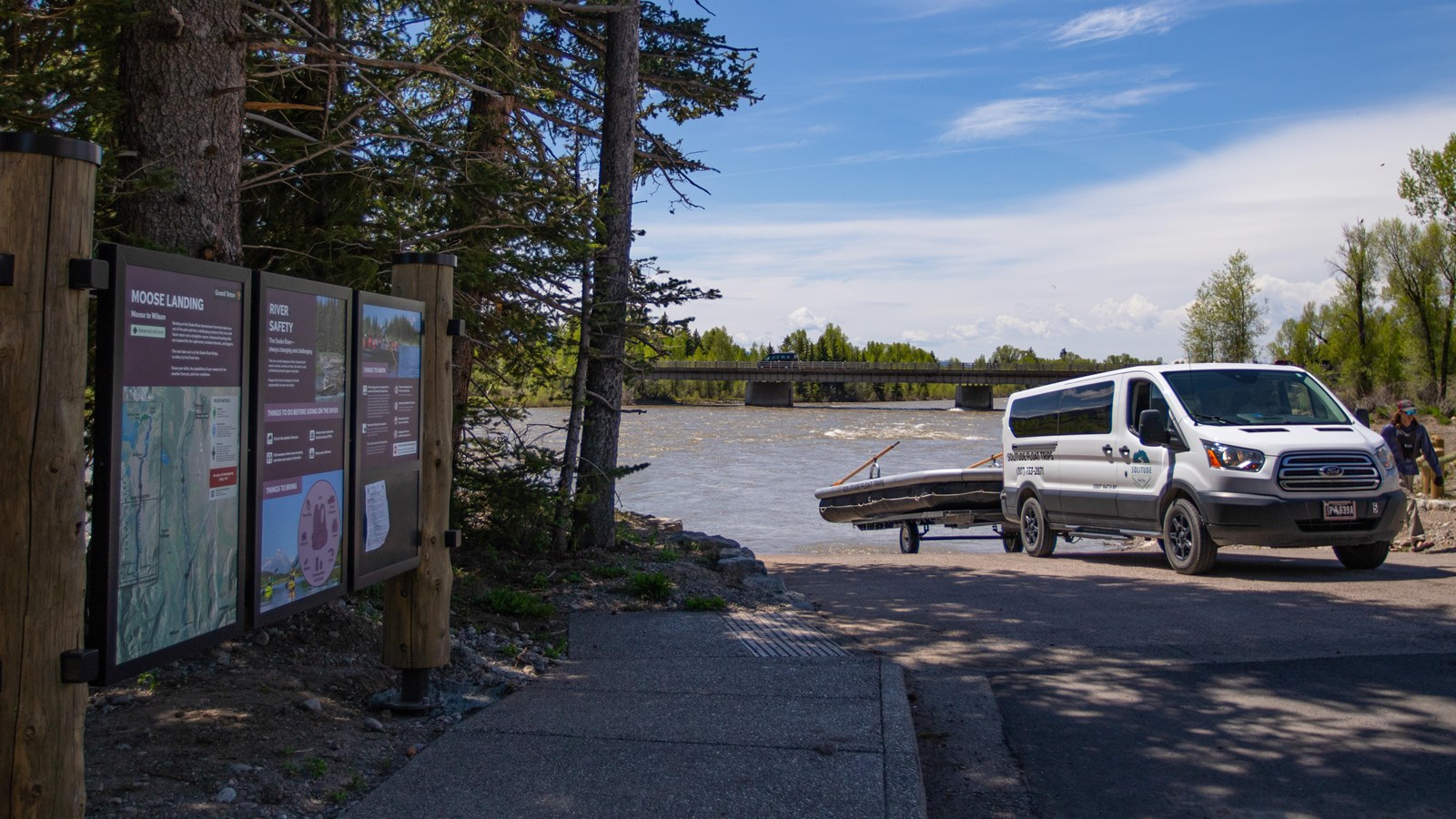Last updated: September 30, 2025
Place
Moose Landing Boat Launch

NPS Photo/G. Lemen
Animal-Safe Food Storage, Boat Ramp, Canoe/Kayak/Small Boat Launch, Information Kiosk/Bulletin Board, Parking - Boat Trailer, Recycling, Restroom, Restroom - Accessible, Trash/Litter Receptacles
The Snake River winds through the valley floor carrying snowmelt from the mountains westward toward the Pacific Ocean. This river is an artery of the park, offering stunning views of the Tetons. Many species of wildlife use the river, from the browsing moose to the industrious beaver. Whether you are fishing, viewing wildlife, or enjoying the scenery, floating on this river is an unforgettable experience. Moose Landing is the primary take-out location for boating and float trips in the park. Many authorized float trip operations pick up their guests here and then drive to the put-in location. If you are continuing your trip past Moose Landing or starting your trip here, you should have advanced boating and navigation skills. The next take-out is fourteen miles south in Wilson, WY.
The course this river follows is not straightforward. It travels in and out of numerous channels that change every year. This is a powerful river that requires river reading and navigation skills. Before you float, know what skills you need to float the river, where you are going, and what things you need.
Informational panels on river safety are located at the launch area for you and your group to review. You will find resources like a map, things to do before going on the water, things to bring, and things to know.
For a complete overview of boating rules, regulations, and permit requirements, please review our webpage on boating and floating before getting out on the water.
Additional information about floating the Snake River, including an interactive map, is available too.
Permits and Regulations
To meet the permit requirements for Grand Teton National Park you must:
- Have a Grand Teton Boat Permit
- Have a valid Wyoming AIS Decal
- Complete an AIS inspection
Grand Teton Boat Permit
All boats are required to have a Grand Teton Boat Permit before launching on any of the park’s waters. Permits are required for all motorized and non-motorized boats, including stand-up paddleboards (SUPs) and windsurfing boards. Privately owned vessels must register each year with Grand Teton National Park. Permits may be purchased on Recreation.gov or at the visitor centers in Moose or Colter Bay during summer operations. Boaters can also have their permit mailed directly to them within two weeks.
Wyoming AIS Decal
PREVENT THE SPREAD OF PATHOGENS - CLEAN. DRAIN. DRY.
All watercraft using Wyoming waters are required to display a Wyoming Aquatic Invasive Species decal. The decal can be purchased online at the Wyoming Game and Fish Department website or from a variety of local vendors. Additionally, all boats entering the park must stop for an Aquatic Invasive Species (AIS) inspection. By law, boats coming from out of state must be inspected or have valid proof of inspection before they launch on waters in Wyoming, including waters in the park. This includes motorized boats, rafts, drift boats, canoes, kayaks, stand-up paddleboards, and all watercraft 10 feet and longer. Aquatic Invasive Species, such as whirling disease and zebra or quagga mussels, are a serious ecological and economic threat to the Greater Yellowstone Ecosystem. Boats, waders, and anything else that comes in contact with a body of water has the potential to spread non-native plants, pathogens, and other invasive species among water bodies. Clean, drain, and dry all boating and fishing equipment after use. Learn more about preventing the spread of AIS.
Note: Non-motorized inflatable watercraft 10 feet or less in length, all solid and inflatable paddleboards regardless of length, and all devices defined as water sport toys are exempt from the Wyoming State AIS Decal requirement.
Stretches of River
Beginner
Jackson Lake Dam to Pacific Creek 5 miles
This stretch features scenic views, calmer water and few obstructions. At Pacific Creek landing the water is swift, boaters should scout this landing prior to launching.
Intermediate
Pacific Creek to Deadmans Bar 10 miles
This section drops significantly creating swift water and braided channels requiring careful route-finding.
Flagg Ranch to Lizard Creek Campground 10 miles
The braided channels make route-finding a challenge. The river winds for 6 miles before reaching Jackson Lake. Depending on the lake level, the trip is another 4 miles to Lizard Creek Campground. Strenuous rowing or paddling may be required. Afternoon thunderstorms and winds produce waves that may swamp canoes. Motors may be used on Jackson Lake.
Advanced
Deadman’s Bar to Moose Landing 10 miles
This is the most challenging stretch of river in the park—many accidents occur here. The river drops more steeply and the current increases. Complex braiding may obscure the main channel and strong currents can sweep boaters into side channels blocked by logjams.
Moose to Wilson 14 miles
This section of the river is as difficult as the preceding section. Advanced boating skills are required due to fast current, braided channels, and logjams. The park extends 5 miles downstream from Moose on the west bank and 2 miles downstream on the east bank. There is no take-out or access to the river at the park boundary. The next take-out is at the Snake River Bridge east of Wilson, WY, 14 miles downstream from Moose.
Use our advanced Snake River Map on our website for more route details.
